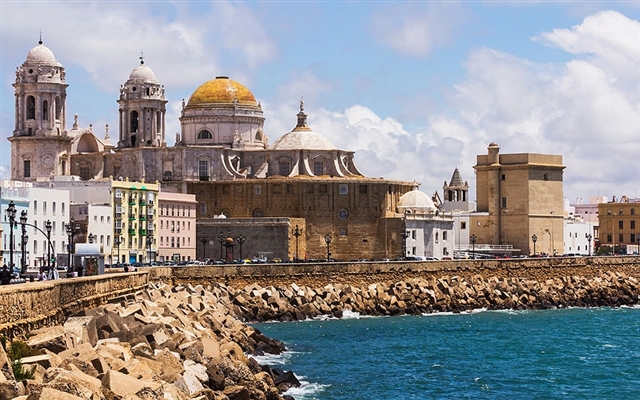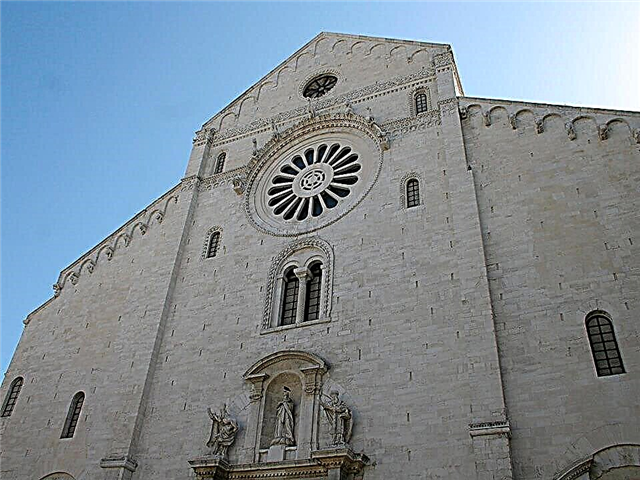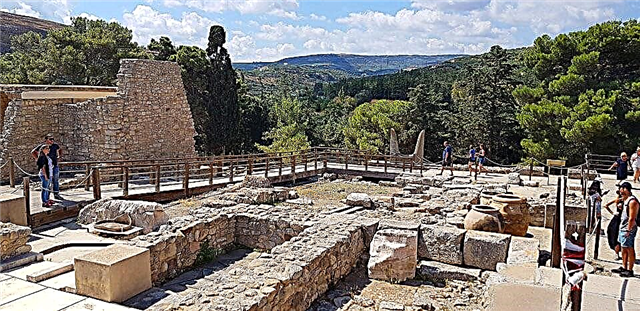The Palace of Knossos in Crete is a must-see place for tourists. And there is an explanation for this: the complex is located near the capital of Crete, the city of Heraklion. But it's not just the comfortable position that attracts guests. The center is a revived testimony of an ancient civilization. Walking along the passages, studying ancient frescoes, it is easy to imagine the life of the townspeople 2000 BC. And the legends that cover the ancient building add charm to the ruins.
Construction history

The first palace of Knossos was supposedly built by the Minoans in 2000 BC. And already in 1700 the building was almost completely destroyed by an earthquake. Then not only this palace perished: almost all buildings on the island were destroyed by the elements. But after a while the building was restored. It was the time of the full flowering of the Cretan civilization, so the building surpassed the previous one in beauty, grace and luxury. But it did not last long: in 1450 BC. died again. Experts are still arguing about the reason for the disappearance of the building. Scientists consider it a miracle that parts of the palace were excavated and reconstructed.
Discovery by Evans

Initially, excavations at the site of the Knossos Palace were carried out in 1878 by the Greek archaeologist Kalokerinos. He managed to find some artifacts, after the publication of which Europeans showed interest in excavations. The Englishman Arthur Evans is one of them. Evans arrives on the island in 1900 and buys out all the lands where, in his opinion, the remains of the unique building are located. But until 1905 his work could not be called successful: the finds are insignificant and of little interest.
And in 1905, Evans unearthed artifacts, the significance of which can hardly be overestimated:
- abundance of household items
- frescoes Prince with lilies and Procession
- fresco Games with a bull
- fresco Parisienne
- the remains of the palace chambers, including the Throne Room, and service buildings (workshops, storage facilities)
- lettering on boards
But Evans did not stop there: he carried out a large-scale reconstruction of the buildings. At the same time, he himself performed the work of an architect. It is thanks to this colossal work that today's visitors have an idea of what this building was like after the first reconstruction (1700-1450 BC).
Of course, it was not without the introduction of completely new details. All the columns that adorn the building were re-created by Evans: the Minoans used wood to make the columns, which perfectly protected the building from destruction during earthquake shocks, but quickly rotted and damaged by bark beetles. During the reconstruction, the building received columns hewn out of stone.
Scientists do not have a consensus about the correctness of Evans' decision: some believe that it was enough to simply mothball the excavation and transfer the artifacts to museums. But, nevertheless, thanks to the reconstruction, the monument attracts tourists.
Versions of the death of the palace

There are several versions of the final death of the building:
- In 1450 BC. a fire raged on the island, which caused the death of Knossos.
- According to documents, at the same time Crete was captured by Mycenae: a city-state in the mainland of Greece. It is known that the invaders were ruthless, they destroyed everything that came under the hot hand. But there are no specific facts about their rule.
- In 1000 BC. The Mycenaeans were driven out by the Romans (Roman Greece). They began to build on the island according to their own canons. But even less is known about this period in detail.
- In the period from 1450 to 1380 BC. the city and the palace were captured by the Achaeans: it became real due to the fact that the Mycenaean civilization fell into decay. At this time, the palace still existed and was actively used by the new owners. And after 1380 BC. the Achaeans threw the building and left the city.
Scientists have yet to make a final conclusion about the tragedy that befell the unique building.
Creta Maris Beach Resort
Crete
6 outdoor pools, 1 indoor heated pool, 5 children's pools

Blue Palace, a Luxury Collection Resort and Spa, Crete
Crete
State of the art spa, infinity pools and 2 tennis courts

Domes Noruz Chania, Autograph Collection - Adults Only
Crete
Spa center and 2 swimming pools overlooking the azure sea

Minotaur Labyrinth

It is generally accepted that the Palace of Knossos is the labyrinth of the minotaur. This statement is supported by the facts:
- ancient sign labros (labyrinth) on the walls of the room
- chaotic and confusing layout of rooms, corridors, passages
But opponents cite a counterargument: the myth of a monster hidden from people's eyes arose much earlier than the complex was built. All this time, the Minotaur had to be contained somewhere. Presumably, for this, caves were used, of which there are a great many in Crete. In the meantime, scientists argue, tourists willingly visit the complex, imagining that it was here that Ariadne's guiding thread saved the hero Theseus from the monster.
Architecture

Some modern architects believe that calling the complex a palace is wrong. Rather, it is a whole closed city that can exist autonomously. At first glance, Knossos is a confusing and haphazard structure. But its logical center is a courtyard, the size of which is 50x50 meters.
Here winding corridors and passages intersect. The complex has water supply, sewerage, ventilation. It is located both above the surface of the earth and underground. It is noteworthy that the complex has no defensive walls: the Minoans dominated the peoples living in the neighborhood, and were not afraid of enemies. The elements were much more dangerous for civilization.
Throne room and other rooms

The throne room is a perfectly preserved room. It got its name from the massive stone chair. There is a bathtub nearby. Presumably in this room the rulers of Knossos gave an audience. But the complex is famous for other buildings as well. These are premises for the owners of the palace, court nobility and priests.
And other rooms, on the contrary, had a service purpose:
- pantries for storing grain and finished products
- kulures (pits that were used for storing grain or for storing the remains of sacrificial animals)
- artisan workshop
- pool for ablutions of all incoming
The complex had its own customs office: all visitors were inspected in the hall.
Legends and myths

This wonderful place gives rise to wonderful myths:
- Minos himself is the son of Zeus and Europe, kidnapped by the god. But Zeus ordered the ruler of Crete, Asterius, to marry Europe and become the father of her children. That is why Minos became the legitimate ruler of the island, favored by the gods.
- Poseidon gave Minos a white bull, which had a wonderful appearance. But the sea king set a condition: the animal should be sacrificed. However, Minos could not part with the bull, and sacrificed another animal. The deception was revealed: Poseidon made the wife of the earthly king surrender to the white bull. From unnatural passion, a freak was born: he had a bull's head, and a human body. In addition, the monster was angry and aggressive: immediately after birth, he almost swallowed the nurse. The minotaur (together with his mother) was imprisoned in a labyrinth, from where there was no exit. And Daedalus invented and built an intricate building. Anyone who entered the caves was eaten by the monster.
- But there were no people wishing to become food for the Minotaur in Knossos. Therefore, after the victory over Athens, Minos ordered that 7 Athenian girls and 7 Athenian youths be sent to the labyrinth every 10 years. The sacrifice was offered twice. And for the third time Theseus was among the young men. He defeated the Minotaur, and was able to get out of the labyrinth along the guiding thread of Ariadne.
How Minos died, legends do not tell. But even after his death, he continued to dispose of the fate of people in the kingdom of Hades.
Interesting Facts

Arthur Evans conducted the excavation at his own expense, as a result of which his family was nearly ruined.In addition, for an archaeologist, he was too impetuous: instead of a slow clearing, he ordered the workers to dig down all, in his opinion, uninteresting layers. Because of this decision, almost nothing is known about the monument after its second destruction.
Evans lacked hard data. But this did not sadden him: he simply composed the missing architectural details. Some scientists were outraged by this, others were sympathetic to such actions. In addition, the scientist masterfully restored the unique Minoan frescoes. The Greeks appreciate the work done by the Englishman: on the territory of the excavation there is a monument to the selfless architect.
Some modern architects consider Knossos to be an old skyscraper, and very comfortable: the building had several floors, ventilation, sewerage, plumbing and lighting. The mythical Minotaur, who lived in the labyrinth, was transferred by Dante to the Divine Comedy: a half-beast-half-man became a judge and executioner in a hellish circle. And the popularity of the Minotaur has not diminished since then.
The Minoans created a more developed civilization than the Greeks: the cities of the latter were the colonies of Crete. The main rivals of the island state were Egypt and Mesopotamia. This conclusion was made by scientists after studying artifacts at the Knossos excavation site. The complex is a museum and at the same time a center of study: excavations on the territory are periodically renewed: perhaps later finds will answer numerous questions of scientists.
Opening hours and ticket prices

For an adult tourist, the entrance ticket costs 15 euros, for children under 18 years old, a ticket is not required. In order to save money, you should buy a ticket on the official website.
And you can go for free:
- during the winter months (November-April): every first Sunday
- on international tourism day: September 27
- on holidays (indicated on the official website of the palace)
During the holiday season (May-October), the center receives visitors daily from 8 am to 7 pm. In winter (November-April) the complex is open from 9 am to 3 pm. Half an hour before closing time, guests are no longer allowed to enter the territory.
Where is it located and how to get there

The attraction is located at: Minoiton, Heraklion 71409. You can get here in several ways:
- By bus from Heraklion. Route number - 2, travel interval 10 minutes. Get off at the last stop.
- By taxi. Since the destination is only 6 km from the center of Heraklion, it is inexpensive.
- With a rented car. This is a convenient type of travel: there is a parking lot next to the monument. And the trip itself from Heraklion will not take much time. When driving from another city, you should use a navigator.
If the starting point of the route is not Heraklion, but you plan to move by public transport, then it is recommended to first get to the city bus station, then take bus number 2 and follow to the final stop.











